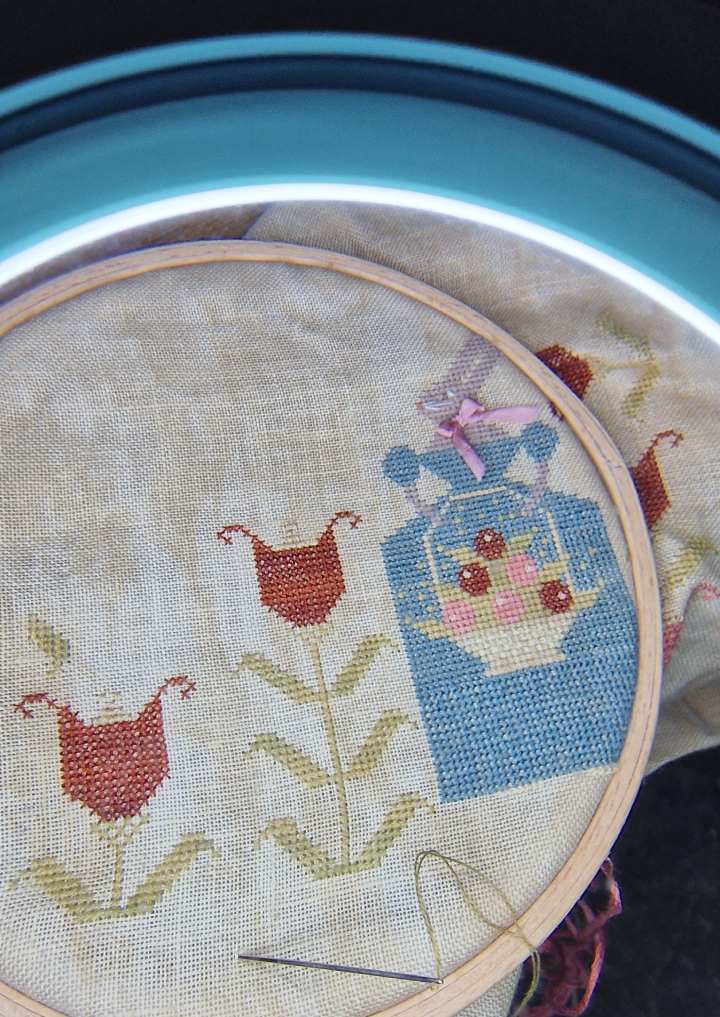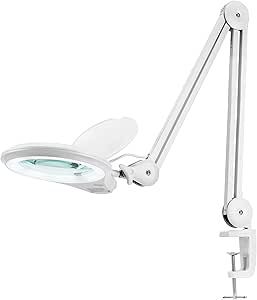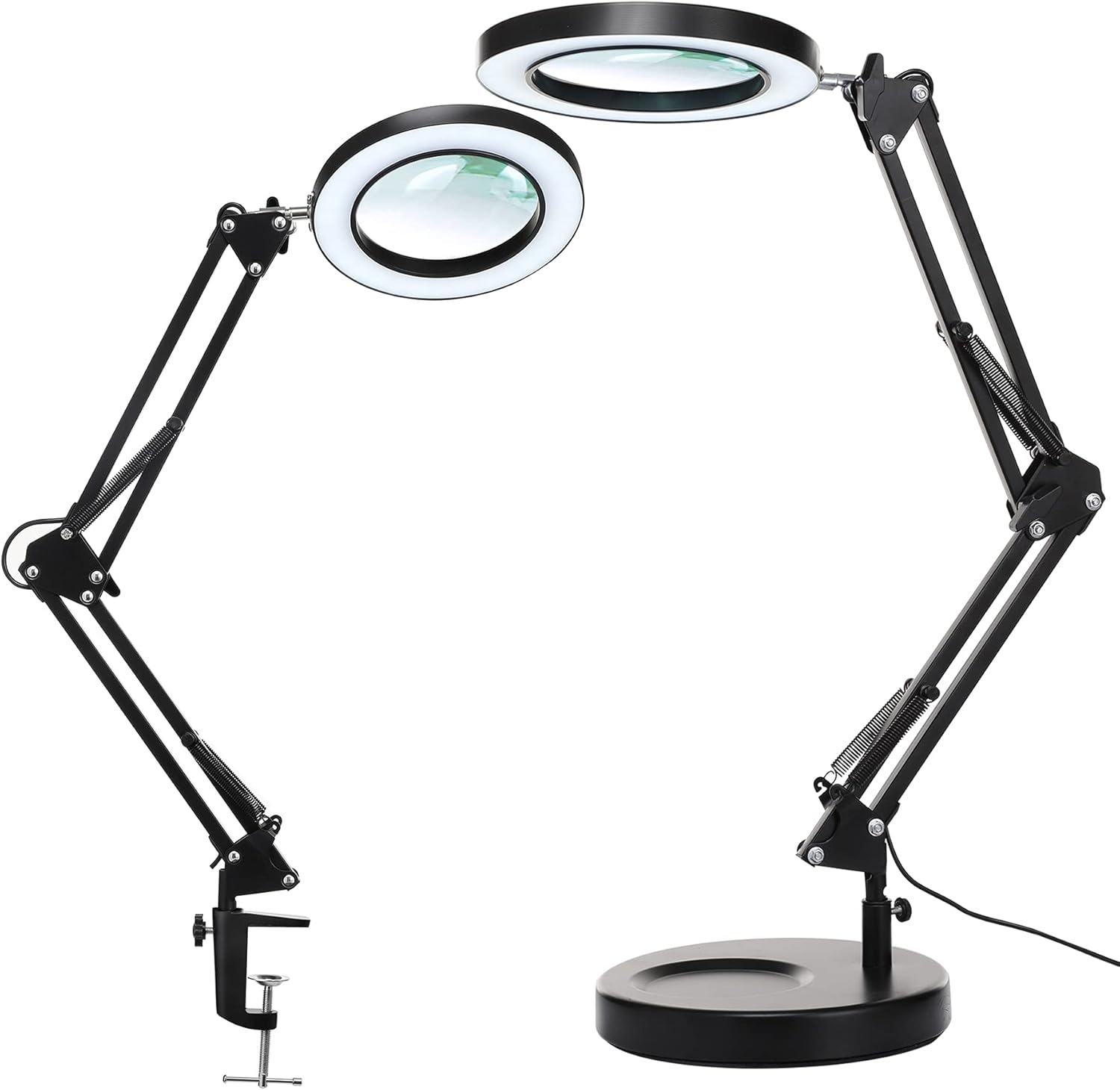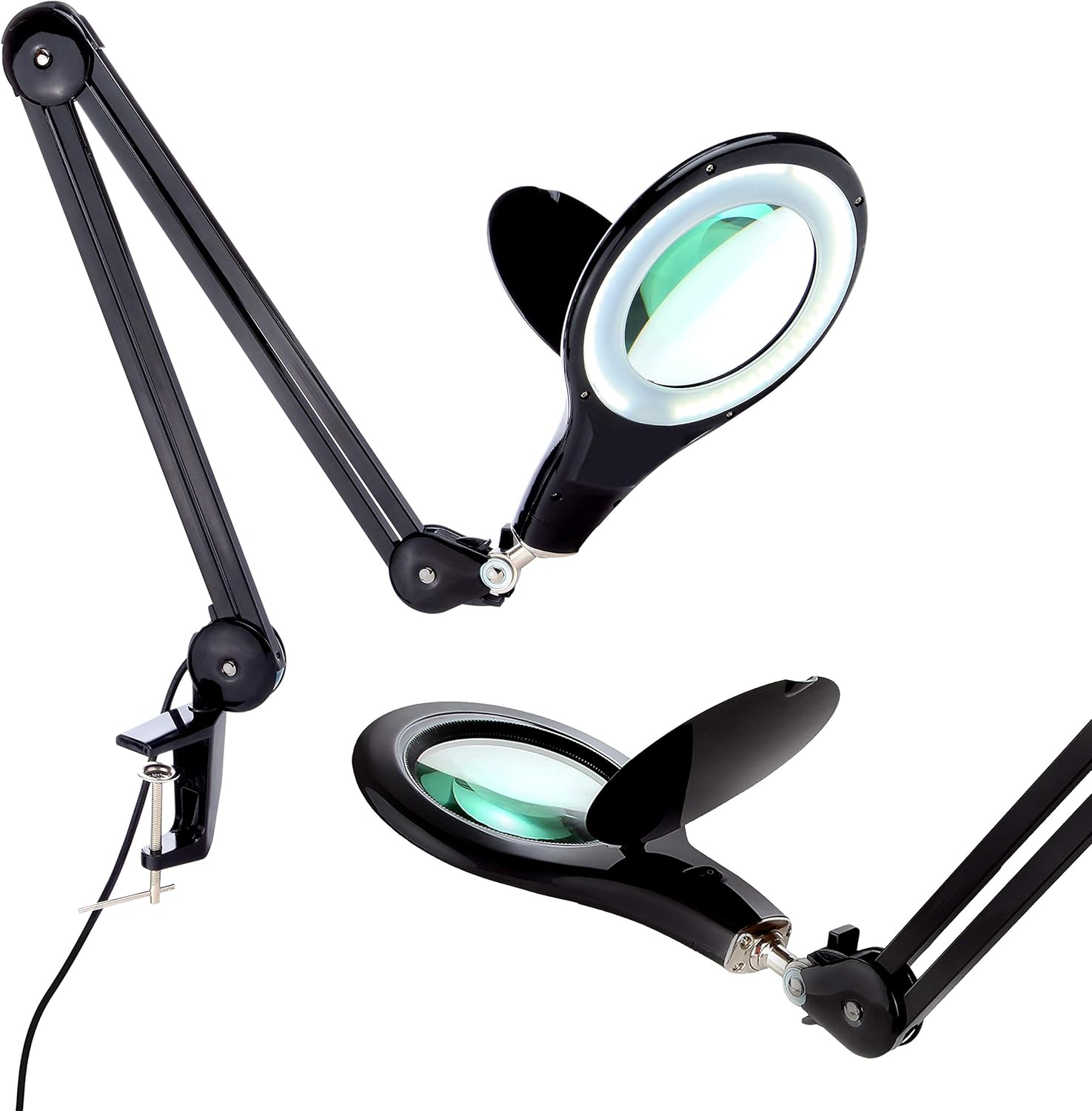Popular Craft Lights for 2025

I spent days working on a With Thy Needle & Thread ~ Tulip Festival cross-stitch, on 36-count linen squinting at the pattern like I was trying to read the fine print on a pharmaceutical insert. My eyes hurt and my neck ached from leaning into whatever little patch light I could find. The overhead fluorescent of my old anglepoise made everything look like a DMV office - harsh, cold, and somehow both too bright and too dim at the same time. Whether you're working on detailed beadwork projects, needle felting, or weaving on a loom, proper lighting transforms the experience.
When I discovered what 1,200 lumens of properly directed LED light plus a 5-diopter magnifier could do to a workspace, suddenly I could see individual thread fibers at midnight. It was like someone had cleaned windows I didn't know were dirty.
This isn't about finding the "perfect" craft light. It's about understanding what actually matters when you're trying to thread a needle at 10 PM or paint miniature details without developing a permanent squint. The technology has gotten legitimately good, and the differences between models actually mean something now.
The Current State of Craft Lighting
Here's what's happening: LED technology finally caught up with what crafters actually need. We're talking about lights pumping out 2,200 lumens - that's brighter than most car headlights. Magnification has evolved from those awful plastic fresnel lenses that distorted everything to genuine optical glass with anti-glare coatings. Color temperatures now range from 3000K (warm sunset) to 6000K (arctic noon), and you can actually dial in exactly what works for your eyes.
The market has split into three distinct camps, each solving different problems.
The Bifocal Revolution: Neatfi's Dual-Lens System

Neatfi Bifocals Magnifying Light
Neatfi figured something out that seems obvious in retrospect: people need different magnification for different moments. Their bifocal system gives you a 5-diopter main lens (that's 2X magnification) for general work, plus a 20-diopter spot lens (6X) built right into it for when you need to examine something at forensic-level detail.
The engineering here deserves attention. They've arranged 60 SMD LEDs in a pattern that essentially eliminates shadows - light comes from multiple angles simultaneously, wrapping around your work. At 1,200 lumens, it's bright enough to be your only light source in a completely dark room. The color temperature sits at 5600K-6000K, which sounds technical but basically means it mimics noon daylight without the UV that makes your eyes tired.
What actually matters: the lens is 5 inches across, giving you a decent field of view without constantly repositioning. The arm extends 31 inches and holds position without drooping - a seemingly minor detail that becomes crucial after hour three of detailed work. Four brightness levels (25%, 50%, 75%, 100%) let you dial in exactly what your eyes need. The whole system draws 12 watts, which translates to about 14 cents per month if you use it four hours daily.
Key specifications:
- 5-inch lens with 5-diopter (2X) main magnification
- Built-in 20-diopter (6X) spot lens for extreme detail
- 1,200 lumens with four brightness levels
- 60 SMD LEDs arranged for shadow elimination
- 31-inch adjustable arm with stable positioning
- 30,000-hour LED lifespan
The clamp opens to 2.5 inches, fitting most desks. If your setup doesn't work with clamps, you can get a mounting bracket that converts it to a desk-mounted or wall-mounted setup. Price typically runs $120-160.
The Brightness Monster: KIRKAS's 2,200-Lumen Approach

KIRKAS 10X Magnifying Light
KIRKAS went a different direction entirely. Instead of dual lenses, they decided to solve the problem with sheer photon output. Their 2,200-lumen model produces nearly twice the light of most competitors. To put that in perspective, that's brighter than most bathroom vanity fixtures. In a dark room, this thing could double as emergency lighting for a small apartment.
The 10X magnification (that's 20 diopters) reveals details you didn't know existed. Thread fibers separate into individual strands. Printed text becomes a landscape of ink absorption patterns. It's almost too much magnification for some work - you might find yourself backing off to see the bigger picture. But when you need to see exactly where that beading needle is going, or read component markings on a circuit board, this level of detail becomes essential.
They've implemented stepless dimming, which sounds like marketing speak but actually means something. Instead of clicking between preset levels, you hold the button and watch the light gradually fade or brighten to exactly where you want it. It's one of those features you don't think you need until you've spent an evening gradually adjusting to changing natural light without having to make jarring jumps between brightness levels.
Key specifications:
- 10X magnification (20 diopter) optical glass lens
- 2,200 lumens maximum brightness
- Stepless dimming control (infinite adjustment)
- Real glass lens with anti-glare coating
- 144 LED array for even light distribution
- Metal clamp with 2.3-inch opening
The glass lens makes a difference here. Plastic lenses, even good ones, introduce subtle distortions that become obvious after extended use. Glass stays clear, doesn't scratch as easily, and won't yellow over time. The anti-glare coating reduces eye strain during marathon sessions. At $50-65, it's surprisingly affordable for what you're getting.
The Steady Veteran: Brightech LightView Pro

Brightech LightView Pro LED Magnifying Light
Sometimes you don't need innovation. You need something that works reliably, day after day, without drama or learning curves. That's Brightech's position in this market. Their LightView Pro has been fundamentally unchanged for five years because it doesn't need to be.
The 2.25X magnification (about 7 diopters) hits what seems to be a sweet spot for most detailed work. It's enough magnification to make a real difference without the disorientation that comes with higher powers. The 800 lumens won't light up a cave, but it's perfectly adequate for most craft work, especially if you have decent ambient lighting.
What Brightech understands is durability. The arm uses internal springs rather than friction joints, meaning it won't develop that annoying droop that cheaper lights suffer from after a few months. The housing is actual metal, not metallized plastic. The power supply is external, so if it fails (the most common failure point in LED lights), you can replace just that component rather than the entire light.
Key specifications:
- 2.25X magnification (7 diopter) genuine glass lens
- 800 lumens with 6000K daylight color
- 5-inch diameter lens
- Spring-balanced arm system
- Metal construction throughout
- External replaceable power supply
The color rendering index (CRI) is 85, which matters more than you might think. CRI measures how accurately colors appear under the light. Anything above 80 means colors look natural rather than washed out or shifted. For matching thread colors or mixing paints, this becomes crucial. Price hovers around $70-80.
Understanding What These Numbers Actually Mean
Let me translate the technical specifications into what happens at your craft table.
Lumens: This is raw brightness. Below 600 lumens, you're still relying on room lighting. 800-1000 lumens can be your primary light source for detail work. Above 1,200 lumens, you could work in a completely dark room. Above 2,000 lumens, you might need sunglasses. (That's a joke. Mostly.)
Color Temperature: Measured in Kelvin (K), this determines whether light feels warm or cool. 3000K looks like evening sunlight - cozy but not ideal for color accuracy. 5000K-6000K mimics noon daylight and shows colors most accurately. Some people find 6000K harsh for evening work; others love the clarity.
Magnification: Here's where marketing gets creative. Some companies advertise "10X magnification" when they mean 10 diopters, which is actually 3.5X magnification. The conversion isn't linear because optics doesn't care about our convenience. That chart I included earlier becomes useful when comparing different models.
Diopter Magnification Converter
| Diopter | Magnification | What You'll See |
|---|---|---|
| 2 | 1.5X | Slightly enlarged, comfortable for extended viewing |
| 3 | 1.5X | Similar to 2 diopter, minimal difference |
| 4 | 1.75X | Noticeable enlargement, still natural feeling |
| 5 | 2X | Everything doubled, most common for craft work |
| 7 | 2.25X | Good detail without disorientation |
| 8 | 2.75X | Significant magnification, narrower field of view |
| 9 | 3.25X | High magnification, requires steady positioning |
| 20 | 6X | Extreme close-up, very narrow field of view |
The Reality of Working with Magnification
Here's something nobody mentions: magnification changes how you work, not just how you see. At 2X, you can still maintain natural hand movements. At 6X, you're operating in slow motion - every tremor becomes an earthquake, every breath shifts your view. It's not better or worse, just different. Like switching from a pencil to a technical pen.
The distance between your eyes and the lens matters too. Most lights work best at 8-12 inches from the lens. Too close and you fog it up. Too far and you lose the magnification benefit. This is why adjustable arms matter - they allow positioning the lens at the optimal working distance, not just where it's convenient.
The Setup That Actually Works
After watching dozens of people struggle with craft lights, patterns emerge. People who love their lights position them slightly to their dominant side, angled across their work area. This minimizes shadows from your hands. The light should come from above and behind the lens, not from the side, which creates glare.
Clamping versus desk-standing versus floor-standing depends entirely on your space. Clamps are most stable but require an edge. Weighted bases work anywhere but eat desk space. Floor stands free up your table but can be unwieldy. There's no universal answer here - just what works in your specific situation. For extended craft sessions, pairing good lighting with proper seating support can prevent the back and hip fatigue that often ends projects earlier than eye strain does.
The Economic Reality
These lights range from $50 to $200, which seems like a lot for what's essentially a magnifying glass with LEDs. But consider: at 30,000-hour lifespans, even daily use means 20+ years before the LEDs dim. The electricity cost is negligible - maybe $2 per year. Compare that to the cost of eye strain, abandoned projects, or mistakes from poor visibility.
The sweet spot seems to be $80-120. Below that, you're compromising on either brightness or optics. Above that, you're paying for features that might not improve your actual experience - USB charging ports, remote controls, memory functions that remember your last brightness setting. Nice to have, but not essential.
What Actually Happens When You Upgrade
I watched someone switch from a 400-lumen desk lamp to a proper 1,200-lumen craft light. Their first reaction wasn't about the brightness - it was about the shadows, or rather, the lack of them. Multi-directional LED arrays eliminate the harsh shadows that make detail work exhausting. Suddenly, they could work for three hours instead of one before fatigue set in.
The magnification reveals problems you didn't know you had. That "perfectly straight" seam isn't. That "matching" thread doesn't. That "smooth" paint job looks like the surface of the moon. This isn't discouraging - it's enlightening. You can't fix what you can't see.
Beyond the Big Three
The market extends beyond these major players. Tomsoo makes ultra-budget options that work fine for occasional use. OttLite focuses on full-spectrum lighting that some swear by for color matching. Daylight Company offers specialty options for specific crafts. Each has found their niche.
Chinese manufacturers on Amazon offer suspiciously similar lights at half the price. Sometimes they're identical products with different branding. Sometimes they're inferior copies that fail after six months. The three-year warranties from established brands start looking pretty good when you're staring at a dead light after month seven.
The Bottom Line
Craft lighting has reached a point where the technology exceeds most people's needs. Most crafters don't require 2,200 lumens unless doing extremely fine work. 10X magnification becomes relevant mainly for truly tiny components. Bifocal lenses serve those who frequently switch between detail and overview work.
What makes the difference for most crafters is having enough light to work without strain, sufficient magnification to see clearly, and adjustability for comfortable positioning. For typical craft work, that translates to 800-1,200 lumens, 2X-3X magnification, and a stable adjustable arm. Everything else comes down to preference and specific use case.
The transformation these tools provide isn't subtle. It's the difference between struggling and flowing, between guessing and knowing, between "good enough" and "exactly right." In a craft where precision matters - and what craft doesn't involve some precision? - proper lighting isn't a luxury. It's the foundation everything else builds on.
Each model has its strengths. The Neatfi offers versatility with its dual-lens system. The KIRKAS delivers maximum brightness for those who want it. The Brightech provides proven reliability over years of use. Any of them will transform a workspace from a place where seeing is a struggle into a place where creation flows naturally. The specific choice matters less than making the upgrade from inadequate lighting at all.